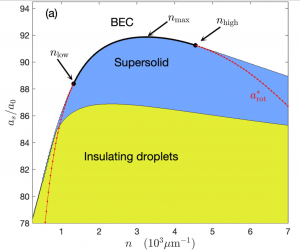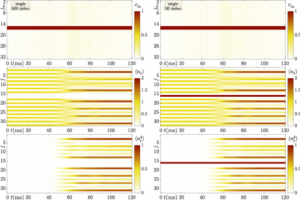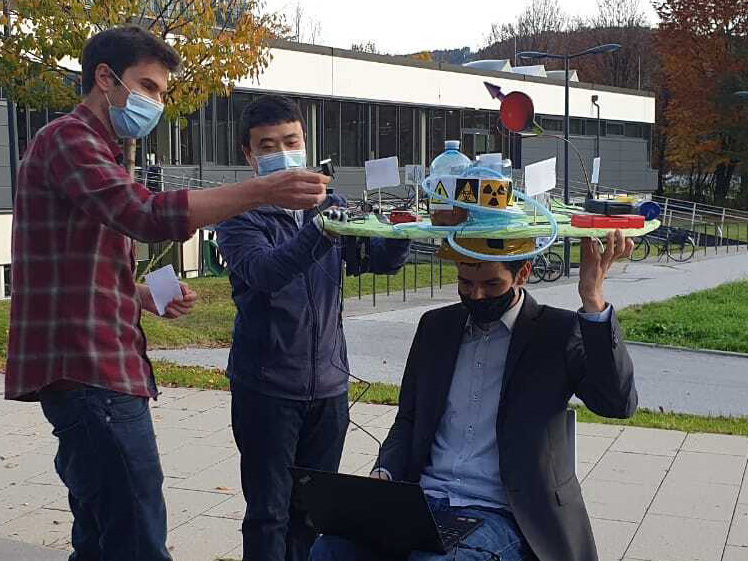
Long-Range Interactions Workshop 2025
Register now for the Long-Range Interactions Workshop 2025!

2025 Group Openings!
We are happy to announce that our dipolar quantum gas group has an Academy Scientist + Postdoc and PhD positions open for 2025!

Vortices in a supersolid
2024’s Biggest Breakthroughs in Physics: Our research on the observation of vortices in a dipolar supersolid featured by Quanta magazine!

Austrian of the Year 2024
Francesca was crowned as the ‘Austrian of the Year’ in the research category at the Austria 24 gala by Die Presse!

Summer BBQ
Our 2024 Summer BBQ took place on the 24th of June and celebrated the many different achievements of the group!

Murder Mystery Dinner
Our 2024 group dinner took place on the 18th of January at CasoinN da Giorgio restaurant, with a 1920’s Murder Mystery theme!

Glitches in supersolids: links between neutron stars and quantum matter
By emulating the connection between a rotating supersolid phase and an external solid phase, we were able to replicate “glitches” – sudden jumps in the solid angular momentum driven by quantum vortices leaving the supersolid.

Cluster of Excellence Quantum Science Austria granted
Three Clusters of Excellence in Innsbruck have been funded! With highly endowed clusters of excellence, the Austrian Science Fund FWF creates Austrian flagships of basic research. The University of Innsbruck will coordinate the Cluster of Excellence for Quantum Sciences.

Bloch Oscillations
By letting an erbium quantum droplet fall under gravity through an optical lattice, it is possible to understand the inter-atomic interactions and quantum fluctuations through variations of the Bloch oscillation.

ERC Advanced Grant DymetEr has been funded!
Our group studies dipolar quantum gases made of Erbium (Er) and Dysprosium (Dy) atoms. These extraordinarily magnetic species are a powerful new resource for reaching quantum simulation with strong connectivity, in which each atom is coupled to the other over long distances, and exploring exotic phases of matter that have no classical counterpart.
We have three labs: the ERBIUM LAB, where Er was Bose condensed for the first time ever, the Er-Dy LAB which studies quantum dipolar mixtures under a quantum-gas microscope, and the T-REQs LAB, where we trap Er atoms in arrays of optical tweezers for Rydberg physics. Recently, we have established a Theory Group aimed at studying and predicting dipolar phenomena in dipolar quantum gases and mixtures.
The group, led by Francesca Ferlaino, is jointly located at the Institute for Experimental Physics (IExP) of the University of Innsbruck and at the Institute for Quantum Optics and Quantum Information (IQOQI) of the Austrian Academy of Sciences, and it is part of the Innsbruck Center for Ultracold Atoms and Quantum Gases.
Follow our group’s updates on  Bluesky!
Bluesky!
News from the labs
![]()
Now in Science! In the presence of isotropic interactions, the Fermi surface of an ultracold Fermi gas is spherical. Introducing anisotropic interactions can deform it. This effect is subtle and challenging to observe experimentally. We report the observation of such a Fermi surface deformation in a degenerate dipolar Fermi gas of
Keep Reading ...
We have studied the scattering behavior of ultracold Er atoms and observed an enormous number of Fano-Feshbach scattering resonances and demonstrate high correlation in the spectra, underlying chaotic scattering between the particles. This work, now published in NATURE, is a joint effort between our group, John L. Bohn from JILA (Boulder,
Keep Reading ...
We report on the creation of the first degenerate dipolar Fermi gas of erbium atoms. We force evaporative cooling in a fully spin-polarized sample down to temperatures as low as 0.2 times the Fermi temperature. The strong magnetic dipole-dipole interaction enables elastic collisions between identical fermions even in the zero-energy
Keep Reading ...
Group news
Lauriane and Francesca, together with Blair Blakie and Danny Bailly (Otago University), theoretically studied the supersolid phase diagram of dipolar quantum Bose gases in cylindrical geometries. The work is now published in Physical Review Research.
Keep Reading ...
Bing Yang collaborate with Had C. Halimeth, Robert Ottl, Ian P. McCulloch and Philipp Hauke in theoretically studying the robustness of an ultra cold-atom quantum simulator against defects.
Keep Reading ...
Dani held his defense for his PhD thesis and is now officially a Doctor of Philosophy. He will continue to carry out his research as a post-doctoral fellow beginning of next year in the group of David Norris at the ETH. Congratulations and good luck!
Keep Reading ...
Welcome and goodbye
 Bluesky!
Bluesky!












